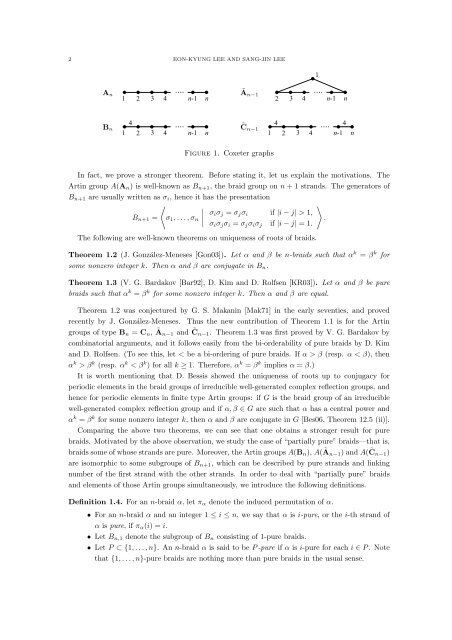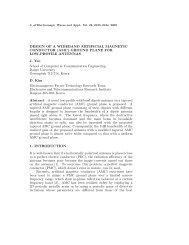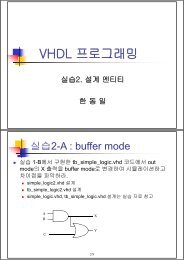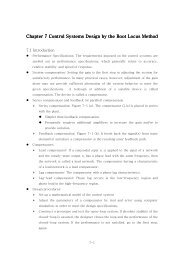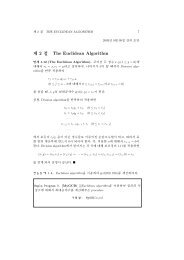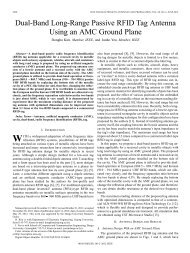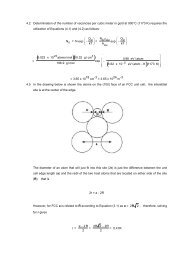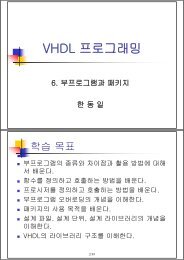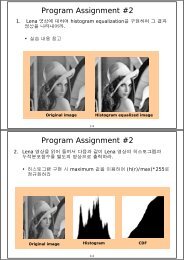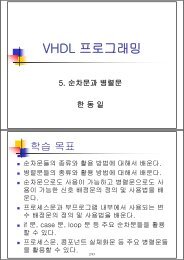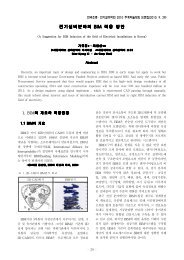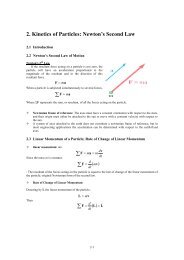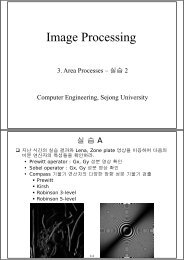UNIQUENESS OF ROOTS UP TO CONJUGACY FOR SOME ...
UNIQUENESS OF ROOTS UP TO CONJUGACY FOR SOME ...
UNIQUENESS OF ROOTS UP TO CONJUGACY FOR SOME ...
You also want an ePaper? Increase the reach of your titles
YUMPU automatically turns print PDFs into web optimized ePapers that Google loves.
2 EON-KYUNG LEE AND SANG-JIN LEE<br />
A n<br />
à n−1<br />
B n<br />
˜Cn−1<br />
Figure 1. Coxeter graphs<br />
In fact, we prove a stronger theorem. Before stating it, let us explain the motivations. The<br />
Artin group A(A n ) is well-known as B n+1 , the braid group on n + 1 strands. The generators of<br />
B n+1 are usually written as σ i , hence it has the presentation<br />
B n+1 =<br />
〈<br />
σ 1 , . . . , σ n<br />
∣ ∣∣∣ σ i σ j = σ j σ i if |i − j| > 1,<br />
σ i σ j σ i = σ j σ i σ j if |i − j| = 1.<br />
The following are well-known theorems on uniqueness of roots of braids.<br />
Theorem 1.2 (J. González-Meneses [Gon03]). Let α and β be n-braids such that α k = β k for<br />
some nonzero integer k. Then α and β are conjugate in B n .<br />
Theorem 1.3 (V. G. Bardakov [Bar92], D. Kim and D. Rolfsen [KR03]). Let α and β be pure<br />
braids such that α k = β k for some nonzero integer k. Then α and β are equal.<br />
Theorem 1.2 was conjectured by G. S. Makanin [Mak71] in the early seventies, and proved<br />
recently by J. González-Meneses. Thus the new contribution of Theorem 1.1 is for the Artin<br />
groups of type B n = C n , Ãn−1 and ˜C n−1 . Theorem 1.3 was first proved by V. G. Bardakov by<br />
combinatorial arguments, and it follows easily from the bi-orderability of pure braids by D. Kim<br />
and D. Rolfsen. (To see this, let < be a bi-ordering of pure braids. If α > β (resp. α < β), then<br />
α k > β k (resp. α k < β k ) for all k ≥ 1. Therefore, α k = β k implies α = β.)<br />
It is worth mentioning that D. Bessis showed the uniqueness of roots up to conjugacy for<br />
periodic elements in the braid groups of irreducible well-generated complex reflection groups, and<br />
hence for periodic elements in finite type Artin groups: if G is the braid group of an irreducible<br />
well-generated complex reflection group and if α, β ∈ G are such that α has a central power and<br />
α k = β k for some nonzero integer k, then α and β are conjugate in G [Bes06, Theorem 12.5 (ii)].<br />
Comparing the above two theorems, we can see that one obtains a stronger result for pure<br />
braids. Motivated by the above observation, we study the case of “partially pure” braids—that is,<br />
braids some of whose strands are pure. Moreover, the Artin groups A(B n ), A(Ãn−1) and A( ˜C n−1 )<br />
are isomorphic to some subgroups of B n+1 , which can be described by pure strands and linking<br />
number of the first strand with the other strands. In order to deal with “partially pure” braids<br />
and elements of those Artin groups simultaneously, we introduce the following definitions.<br />
Definition 1.4. For an n-braid α, let π α denote the induced permutation of α.<br />
• For an n-braid α and an integer 1 ≤ i ≤ n, we say that α is i-pure, or the i-th strand of<br />
α is pure, if π α (i) = i.<br />
• Let B n,1 denote the subgroup of B n consisting of 1-pure braids.<br />
• Let P ⊂ {1, . . . , n}. An n-braid α is said to be P -pure if α is i-pure for each i ∈ P . Note<br />
that {1, . . . , n}-pure braids are nothing more than pure braids in the usual sense.<br />
〉<br />
.


